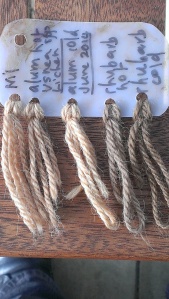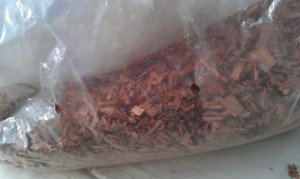I could tell the Guild member who suggested that I be the one to use some of the plant dyestuffs that have been left at the Guild was as appalled as I was to see that there was a large plastic bag full of packs of lichens in one of the cupboards. They were packaged up in such a way as to suggest they might have been purchased dried from a supplier in a time when understanding of the precarity of lichen was less widespread. Concern for the wellbeing of dyers and the planet is widespread at the Guild now and I assume, it was widespread there in the past when levels of information were different, too. I think it would be well recognised now that these are not sustainable dyes. And to be honest, the descriptions of the colours some of these lichens will give made me wonder why anyone would disturb something so slow growing when there are prolific sources readily accessible in the suburbs. No point asking now. No way to know when these lichens were harvested, either. I am guessing, many years ago.
The only thing sadder than these lichens having been killed for dyeing would be composting them without using them at all–So I chose one of the types of lichen for which I could readily find instructions and began what is going to be a lengthy investigation. Out of the bag with ‘Usnea spp’ and into rainwater for a long soak.
I took Karen Casselman’s advice and steeped for some days in an alkaline solution before heating and cooling several times.
On the big day (9 days after beginning), I strained out the lichen—using a pair of preloved pantyhose which had been thoughtfully brought into the Guild for just such purposes to strain out all the itty bitty lichen particles. Then the diluting, heating and dyeing began. One of my new rolls royce sampler cards (two different mordants, two different applications of each) and 50g of Polwarth entered the pot.
I simply don’t have the experience to know whether I did something wrong, or the age of the lichen made a difference, or what-but both my sample card and my fleece turned tan while the dye bath remained orange.
Not so special, in my opinion.
The stash of dyestuff also included many items that were labelled, and some which were identifiable without labels, and then there were some like this:
I checked with my sweetheart, who was a long time woodworker. She said ‘looks and smells like meranti to me’. This looks quite unlike osage orange, sandalwood and logwood (all of which were present in the trove from the Guild). I did a test… and nothing exciting happened. This batch of wood shavings went to the compost.

The rest was sorted out and repackaged and relabelled where necessary. Ready for further dyeing adventures!








From what I have read the best is to keep the fibre and lichen in one pot, but it’s often tough job to clean the fleece afterward. Also, if ammonia is used then the lid must be on otherwise it evaporates and the solution becomes less alkaline. But you probably know this. The good thing is as you mentioned that there is plenty other sustainable dyestuff to substitute lichen.
LikeLike
I am always happy to have tips! Now that I have some pre-loved pantyhose in my possession, I’ll be able to keep lichen and fibre in one pot in the future, as I have also read that’s best–and it is what I usually do, to be honest. The fine texture of this lichen made me think I would never get it out of the fibre and my usual methods for keeping bits out of fleece wouldn’t do the job. I did cover my steeping alkaline vat, so that much went well. I am banking up tips for the next lichen experiment…
LikeLike
I have a good book in dyeing with lichen should you need some additional information. ..
LikeLike
now that is very interesting. my daughter gave me Karen Casselman’s book about lichen dyeing for my birthday, and remembering how much lichen lies around in Extremadura where I have a place in Spain I thought it would be interesting to try out, purely as an experiment. I found a lichen that is pretty common on the granite rocks around my house which is in a fairly isolated spot, all arboriculture, grey and black, not at all pretty, which did the red thing when tested with bleach, which means that it should be processed in an ammonia vat. so I did as instructed in a 2 litre glass preserving jar, window cleaning fluid and water. it immediately went a beautiful deep reddish brown. I shook it 6 times a day for a week , then less, brought it home with me – it was in the jar for about 6 weeks all told, but I think it could have been used after three weeks, as by that time it had turned a beautiful blackcurrant juice colour. Turns out it is lasalllia pustulata (see this blog entry which is all about trying out the same lichen http://www.isabellawhitworth.co.uk/whatsnew/studiolog/archive08/may08/may08.html )
so I had to think hard about what to dye, Casselman said purple, will dye anything including synthetics, plastic buttons … what in the world did I want to dye purple? also a very small amount – 1 oz to 250 ml of the original liquid. in fact I got almost a litre of liquid from my jar. I decided I would rebundle a cotton jersey jacket I had already dyed in a bundle in order to try to get the collar and top of the back purple. but I made various mistakes. if you alter the ph you alter the colour, it goes pinker, and rather than use my neutral tap water full of calcium and iron and chemicals I used water butt water – acid! then I hadn’t bargained for the dye soaking through the bundle and so being quite dilute. anyway I ended up with a delicate shade of rose-purple in a great bundle-string pattern on most of the top of the jacket and some lovely maroon string! I must do a blog post about it …
The green tree lichen which is so abundant and available near my house in fact did about the same result as yours!
sorry this is such a long comment!
LikeLike
I look forward to seeing your not-exactly-purple results… sometimes unintended effects are really lovely, and sometimes not so much! It sounds as though you learned a good deal from your first two experiments, which is a fine thing indeed.
LikeLike
had to do a post on my blog straight away, so here it is – saying much the same thing, but with pictures …http://janewheeler.co.uk/blog/2014/06/18/dyeing-with-lichens/
LikeLike
My past attempts with lichen came out pretty much like yours. Clearly you can get better results but like you I don’t have the urge to play with such limited resources. But always interesting to hear how others fare with different dyes.
LikeLike
Thanks, Leonie!
LikeLike
I started experimenting with lichens about a year ago and the results have been quite amazing. Two recommendations – use the lichens whole or put your yarn/fiber in the stocking. That way you can keep using the dye-bath over and over. I make little butterflies of the yarn each week and test the color. Some colors take as long as 6 months to finally develop ( a pink to purple). Others reach their color in a week and stay there.
LikeLike
Thanks for the tips!
LikeLiked by 1 person
Just wanted to point out that tree lichens, like Usnea, can be collected in abundance simply from stormfall, so they are less likely to be a concern in terms of sustainability! (Rock lichen, of course, should absolutely be left be, and no one should be harvesting living/attached tree lichen, which of course may well be the source of these ancient speciments.)
LikeLiked by 1 person
Thanks, Jillian. It seems clear that folk like me who live in dry parts of Australia, have a whole different understanding of lichens than people who have ever seen an abundance of lichen fall after a storm! I don’t doubt you’re describing something that is simply outside my experience.
LikeLike